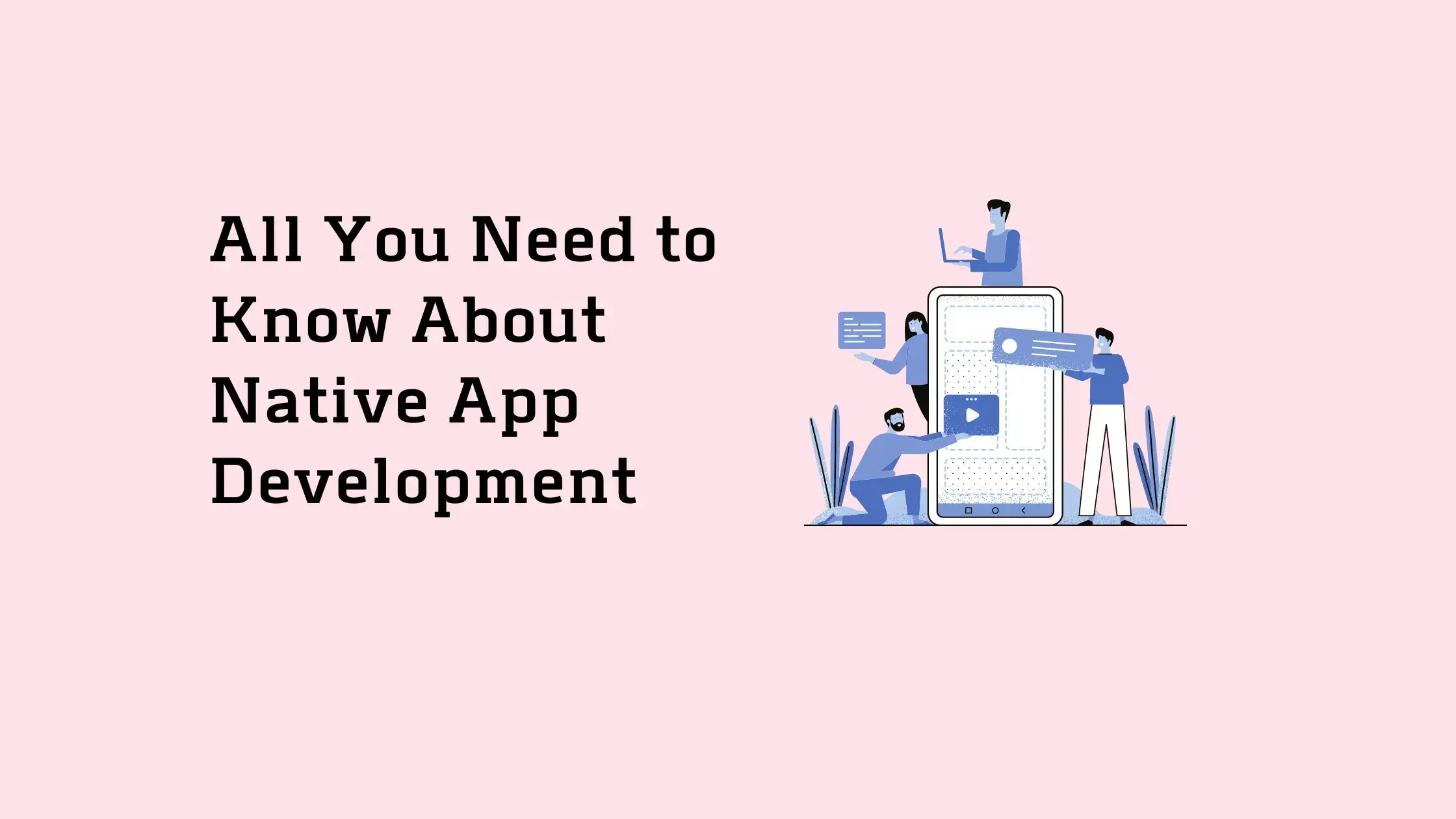Developers create mobile apps using native app development. Mobile app development is often more complicated than Android vs. iPhone.Native app development is another reason software developers are turning to native apps.
Knowing how to create a mobile application in a world where people have more mobile phones than toothbrushes is a great idea. Native app development is a difficult procedure, as described in this article, that requires you to be familiar with the details and any complexities involved.
Mobile apps can do everything for the average smartphone user, from getting up to pay their rent to get them to bed. Native app development is the top choice for developers looking to make mobile apps that are quick and easy for users who rely on their phones for nearly every aspect of daily life.

Learn more about native app development. Continue reading! Consider when hiring a professional is highly recommended.
What is a Native App?
● Native apps are applications specifically designed for a specific platform.
● Mobile app development can be confusing for different platforms. Android, for example, uses Java or Kotlin to develop apps, while iPhone uses Swift and Objective C.
● Swift, Objective C, and Java are considered native languages to match their respective platforms.
● There are many ways to use native app development. These include cross-platform or hybrid development.
● Native app development, according to many software developers, is the best way to create mobile apps. It has inherent advantages over hybrid apps.
Tech companies may spend more time and money to create native apps for every mobile platform, including Android, iPhone, and, at times, such as Windows.
You can add more facts to your collection by considering that 70% of all internet traffic was generated from mobile phones in 2021.
What are the major benefits related to Native App Development?
Using different languages for every platform you plan to launch your apps on sounds tedious and stupid. But unfortunately, this is the choice that professional developers and tech companies make.
Below are some of the benefits that native app development can bring.
Performance
Many software developers believe that mobile apps built natively will result in better performance than other methods.
Native apps are intimately familiar with the OS they run on. This aspect means that native apps will have greater flexibility on native platforms. This factor results in faster processing speeds and response times than mobile platforms. Consider the ultimate guide for also on android apps.
Security
Software professionals believe that native apps are safer. Many hybrid apps can be multi-platform because they use web technologies. However, a native app can access all layers of the OS with security protocols.
Cybersecurity is a topic of great interest in the software industry. Data breaches can damage your reputation and brand, and data.
Functionality
Native app development is easier to integrate and build. It also means that APIs are more compatible with certain elements of the user interface (UI) and user experience (UX) native to your platform.
Native apps offer greater interactivity and navigation. Unfortunately, this advantage cannot be promised by cross-platform development.
What are the disadvantages related to Native App Development
Tech companies continue to launch hybrid apps despite the obvious benefits native apps can offer. Why?
Time-to-Market (TTM)
If you want to create your app on every mobile platform, creating an app using a platform-specific language cannot be easy.
Cost
Time is money. This aspect is a simple truth, but business still strives to live by it. Therefore, you will lose more time promoting the app and collecting profits the longer it takes to create an app.
It would assist if you also considered that you might need to use different developers per mobile platform: Android and iOS developers.
This aspect will cost more than a single full-stack team that is only specialized in hybrid app development.
Accessibility
The greatest drawback of native app development lies in its inaccessibility or limited customer reach.
You’re probably familiar with the dilemma of downloading an iOS app.
Perhaps you have an iPhone and want to share your friend’s information via an app. However, your friend doesn’t have app access because he has an Android. You get the idea.
This aspect is not a common occurrence. Software development companies often lack the resources or the ability to release apps on multiple platforms simultaneously.
This aspect means potential users are disappointed, and the company misses a great marketing opportunity. The app is only available to every smartphone user.
What is the cost of developing native apps?
It can cost up to 100,000 US dollars to hire developers. However, software developers get paid well for their work.
Quick Google searches show that mobile app developers make tens of thousands yearly.
Companies can avoid these expenses by outsourcing their software development teams overseas. This aspect will immediately result in a decrease in development costs. Consider a topical blog in native apps.
It would be useful if you also considered that custom-built software comes with a substantial but affordable price tag. Mobile apps are a good example of high price variability in software development.
One person can build a mobile app with little or no financial aid. A simple, small app could cost you $10,000 if your app needs to be noticed. The median cost to create an app is $171,000.
The cost of developing an application depends on many factors. It’s almost like buying a home. App prices can vary depending on the complexity and size of the app and maintenance standards.
It is crucial to remember that native apps can double the cost of software development because you will require to create a separate app for each platform. When you look at native apps, consider the best in:
● Web Apps Development
● Mobile Apps Development
Four examples of Native Apps
It cannot be easy to determine if an app is native by simply looking at it. Nevertheless, what you just read will tell you that native apps are the ones that run fastest on your platform.
Spotify
Spotify offers a streaming service that allows users to listen to music anywhere, at home or on the move. In addition, users don’t need to download any songs or playlists.
Spotify’s use of the cloud is particularly impressive. It has a performance that exceeds what you expect from a hybrid application.
LinkedIn is a social media platform that permits professional networking. Fun, right? Surprisingly it can. Employers and job seekers can better understand their needs in an environment that encourages new connections.
LinkedIn isn’t the only company that made the mistake of using HTML5 to develop native apps. Native was the correct direction. LinkedIn’s native development improved its performance in several categories, such as speed and rendering.
Waze
Waze is a popular mobile navigation app used on tablets and smartphones. Native app development is essential for Waze to function efficiently and effectively.
Native app development allows you to take advantage of your device’s features and ensure accuracy wherever needed.
Pokemon GO
Pokemon GO is an AR game for mobile devices that uses augmented reality (AR). The app allows you to train and battle virtual Pokemon, just like Generation Y and Z did on Toonami.
Other important factors
After players started to cheat on Pokemon GO using third-party software, Niantic, the official game developer, increased the game’s security. Consider the following factors before deciding: Development Skills, Hybrid App Development, Hybrid App Development Tools, Integrated Development Environment, Intuitive Development, Mobile App Development Approach, and Mobile Application Development.
Mobile Development considers the importance of testing in the following dimensions: Functional Testing, Manual Testing, Platform Testing, Scope Of Testing, Security Testing, Beta Testing, Configuration Testing, Entire Testing Process, Field Testing, and Functionality Testing.
Invent a great Device Software and Mobile Device Emulator with Cues From User Activity and Mobile User Interface. You can use Backend Code and Cross-Platform Code with help from the Developer Community and Grant Developers.
Gain Access To Enterprise Systems with Extensive Programming Language Support using Flutter Apps, Flutter 3, Open-Source Technology, Compact Frameworks, and Hybrid Frameworks.
Never neglect the use of Application Services, Individual Services, Correlation Between Application Performance and Google Android Emulator- On Android emulator plus Google Cloud. Consider Design Constraints, Market Share, IPod TouchApp Store, Mobile Front-End, and Front-End Tools for the best Mobile Phone Apps.
Conclusion
Native app development allows you to respond to security threats quickly. However, there are some drawbacks. Simply put, native app development takes much more effort than software like Flutter or React Native to create a hybrid app. Only you can determine if there are any advantages to mobile app development.
Please change the images to a proper dimension. We have discussed this in many meet. Please update all blogs. Thank you.

Dr.Supreena has published two international books in finance with the able guidance of her guide and department at Ethiraj College of Women, University of Madras during her PhD in Economics and Finance. She is the Recipient of Dr Vedagiri Shanmugasundaram (An Oxford Scholar) Award for Outstanding and Successful PhD Candidate from Ethiraj College for Women concerning research record and academic distinction. She is experienced in the domain of finance, digital marketing and information technology writing on Artificial Intelligence, IoT, PaaS and SaaS cloud computing etc. She is NIIT qualified in Advanced Network Computing, Google Certified in digital marketing. Her hobbies to maintain balance and reduce stress are gardening and cooking.


